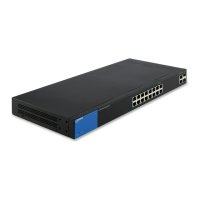172
•
De
stination MAC Address—Select Any if all destination addresses are acceptable
or User Defined to enter a destination address or a range of destination addresses.
•
Destination MAC Address Value—Enter the MAC address to which the destination
MAC address is to be matched and its mask (if relevant).
•
Destination MAC Wildcard Mask—Enter the mask to define a range of MA
C
a
ddresses. Note that this mask is different than in other uses, such as subne
t
m
ask. Here, setting a bit as 1 indicates don’t care and 0 indicates to mask tha
t
va
lue.
Note—Given a mask of 0000 0000 0000 0000 0000 0000 1111 1111 (which
means that you match on the bits where there is 0 and don’t match on the bits
w
here there are 1’s). You need to translate the 1’s to a decimal integer and you
write 0 for each four zeros. In this example since 1111 1111 = 255, the mask
would be written: as 0.0.0.255.
•
Source MAC Address—Select Any if all source address are acceptable or Us
er
Defined to enter a source address or range of source addresses.
•
Source MAC Address Value—Enter the MAC address to which the source
•
MAC address is to be matched and its mask (if relevant).
•
Source MAC Wildcard Mask—Enter the mask to define a range of MAC addresses.
•
VLAN ID—Enter the VLAN ID section of the VLAN tag to match.
•
802.1p—Select Match to use 802.1p.
•
802.1p Value—Enter the 802.1p value to be added to the VPT tag.
•
802.1p Mask—Enter the wildcard mask to be applied to the VPT tag.
•
EtherType—Enter the frame EtherType to be matched.
5. Click Apply. The MAC-Based ACE is saved to the Running Configuration file.

